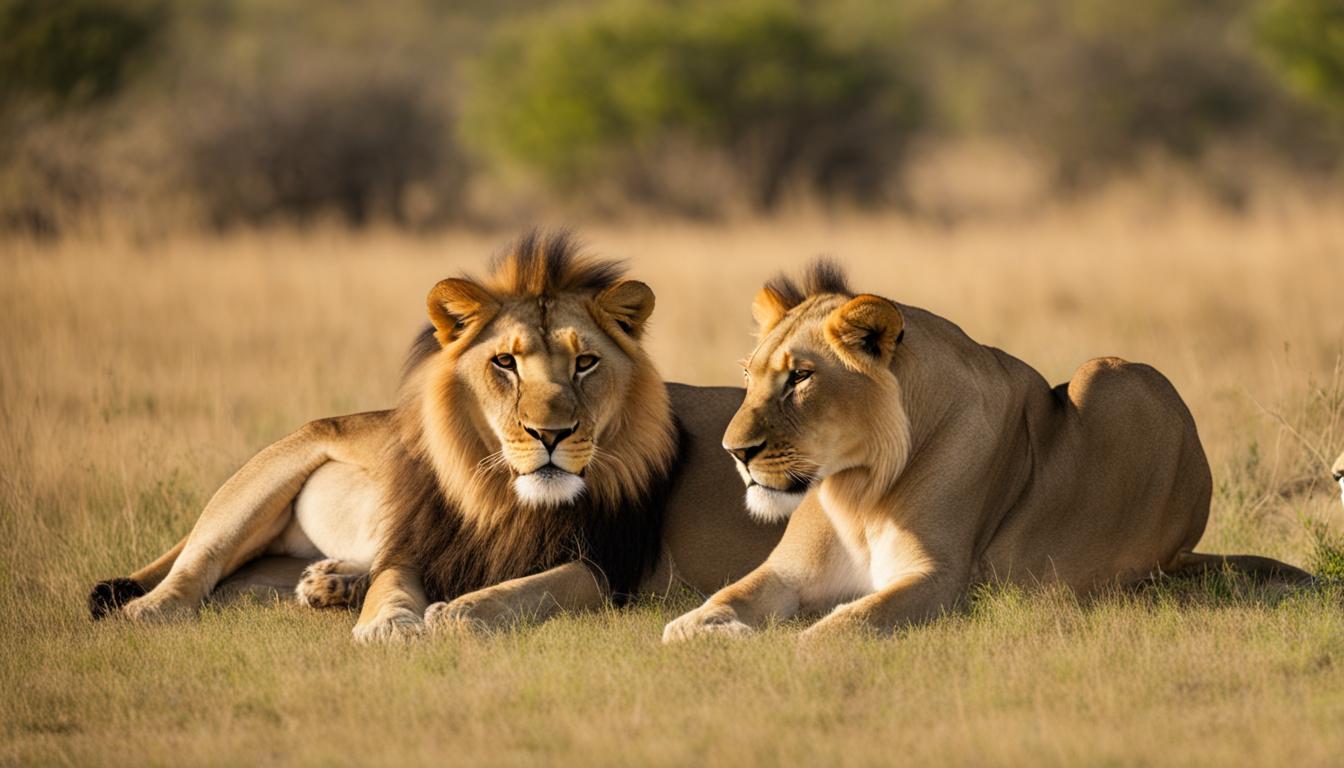Inbreeding within fragmented lion populations is a significant issue in conservation biology. Inbreeding can lead to reduced genetic variation, low reproductive performance, increased cub mortality, and reduced immune competence. To avoid inbreeding depression, a lion population needs to have at least 50 prides with no limits to dispersal. Short-term survival criteria, such as the “rule of 50,” only apply to captive breeding and may not be sufficient for populations in the wild. The ideal population size to retain evolutionary potential long-term is debated, with estimates ranging from 500 to 5,000 adults.
Key Takeaways:
- Lion populations face challenges with inbreeding, which can result in reduced genetic diversity and negative impacts on reproductive performance and overall health.
- At least 50 prides with unrestricted dispersal are necessary to prevent inbreeding depression in lion populations.
- Short-term survival criteria like the “rule of 50” are not sufficient for wild populations.
- The ideal lion population size for long-term evolutionary potential is debated between 500 and 5,000 adults.
- Effective population management is crucial to preserve genetic diversity and prevent inbreeding depression in lion populations.
Factors Influencing Inbreeding Levels in Lions
In lion populations, the increase in inbreeding levels is mostly determined by the number of social groups and the levels of unrestricted male dispersal. The presence of more social groups and greater variance in fecundity among them can help reduce inbreeding. When there are more prides and a higher turnover of males, the chances of mating between closely related individuals decrease, leading to a healthier genetic diversity within the lion population.
However, fragmented populations with limited dispersal opportunities are at a higher risk of inbreeding and the associated negative consequences. These populations often have fewer prides, which results in a higher possibility of lions mating with their relatives. Without enough dispersal and mixing between different prides, genetic variation becomes restricted, leading to a higher prevalence of deleterious recessive alleles and inbreeding depression.
A comprehensive understanding of the factors influencing inbreeding levels in lions is crucial for effective population management. Conservation efforts should focus on promoting unrestricted male dispersal and maintaining an adequate number of social groups to ensure genetic diversity and minimize the risk of inbreeding. By implementing strategies to address these factors, we can protect the long-term survival and health of lion populations.
Factors Influencing Inbreeding Levels in Lions:
- Number of social groups – More prides reduce the chances of mating between closely related individuals.
- Levels of unrestricted male dispersal – Higher turnover of males helps maintain genetic diversity.
- Fragmented populations – Limited dispersal opportunities increase the risk of inbreeding and reduced genetic variation.
Understanding how these factors affect inbreeding levels in lions can inform conservation practices and guide population management efforts. By prioritizing the mitigation of inbreeding risks, we can ensure the long-term viability of lion populations and preserve their genetic diversity.
| Factors | Influences on Inbreeding Levels |
|---|---|
| Number of social groups | More groups reduce inbreeding by decreasing the chances of mating between closely related individuals. |
| Levels of unrestricted male dispersal | Higher turnover of males helps maintain genetic diversity by promoting mating with unrelated females. |
| Fragmented populations | Limited dispersal opportunities increase the risk of inbreeding and reduced genetic variation. |
Male Dispersal and Inbreeding Avoidance in Lion Prides
In lion prides, male lions play a crucial role in preventing inbreeding by their natural behavior of dispersal. After reaching sexual maturity, male lions are expelled from their birth pride and must wander long distances to find a new pride. This expulsion serves as a mechanism to prevent mating with female relatives and ensures genetic diversity within lion populations. When a male lion successfully establishes dominance over a new pride, he gains the opportunity to mate with unrelated females, further reducing the risk of inbreeding.
However, in captive lion breeding programs, where natural dispersal may not occur, there is a higher potential for inbreeding if proper management strategies are not in place. Without the natural dispersal of males, there is a greater risk of closely related individuals being bred together, leading to reduced genetic diversity and increased chances of genetic diseases.
Facts and Figures
| Pride Size | Average Number of Males | Average Number of Females | Dispersal Distance |
|---|---|---|---|
| Small Pride | 1-2 | 2-4 | 50 miles |
| Large Pride | 2-4 | 5-10 | 100 miles |
The table above provides some insights into the typical size of lion prides, the number of males and females within them, and the average dispersal distance of male lions. This data showcases the natural behavior of male lions, highlighting their need to disperse and find new prides to mate with unrelated females, ultimately contributing to genetic diversity and inbreeding avoidance.
In conclusion, male dispersal is a vital mechanism in lion prides to prevent inbreeding. By expelling male lions after sexual maturity and requiring them to establish dominance over new prides, the risk of mating with close relatives is significantly reduced. However, in captive breeding programs, where male dispersal is not natural, it is essential to implement proper genetic management strategies to avoid inbreeding and ensure the long-term genetic diversity and health of lion populations.
Lion Pride Structure and Mating Patterns
Lion prides have a well-defined social structure that plays a crucial role in preventing inbreeding and maintaining genetic diversity within lion populations. Within a pride, there is typically one dominant male lion, known as the lead male or the pride male. This male mates with all the females in the pride, ensuring that their offspring have diverse genetic backgrounds. The females, on the other hand, may also mate with multiple males, further contributing to genetic diversity within the pride.
The lead male’s dominance and exclusive mating rights help reduce the chances of inbreeding within the pride. Additionally, the expulsion of young male lions from the pride when they reach sexual maturity plays a crucial role in preventing inbreeding. These young males must leave the pride and find a new territory, which often involves long-distance wanderings. By establishing dominance over a new pride, these males have the opportunity to mate with unrelated females, thereby reducing the risks of inbreeding.
In addition to the social structure, the timing of sexual maturity in female lions also contributes to the prevention of inbreeding. Female lions typically do not reach sexual maturity until they are around three to four years old. This delay in reproductive maturity allows them to disperse and join new prides, reducing the likelihood of mating with close relatives.
Table: Lion Pride Structure and Mating Patterns
| Key Elements | Description |
|---|---|
| Lead Male | The dominant male lion in the pride who mates with all the females |
| Females | Mate with the lead male and may also mate with other males |
| Expulsion of Young Males | Young male lions are forced to leave the pride when they reach sexual maturity, reducing the risk of inbreeding |
| Female Sexual Maturity | Female lions typically reach sexual maturity around three to four years old, allowing them to disperse and join new prides |
By having this well-defined social structure and mating patterns, lion prides can reduce the chances of inbreeding and maintain genetic diversity within their populations. This is crucial for the long-term survival and health of lion populations, ensuring their ability to adapt to changing environments and pressures.
Kin Recognition and Inbreeding Avoidance in Lions
Lions, like many other species, have developed mechanisms to avoid inbreeding, which can lead to reduced genetic diversity and negative consequences for the population. One of these mechanisms is kin recognition, which allows lions to identify and avoid mating with closely related individuals.
Kin recognition in lions is achieved through various means. One method is through association and familiarity, where lions learn to recognize individuals within their pride through repeated interactions. This helps them distinguish between relatives and non-relatives, reducing the risk of inbreeding.
Another form of kin recognition in lions is based on an individual’s own phenotype. Lions can recognize traits that are common within their family lineage and use this information to avoid mating with close relatives. Chemical cues also play a role, as lions can detect unique scents that differentiate between kin and non-kin individuals. Additionally, the major histocompatibility complex (MHC) genes, which are involved in immune system function, can also serve as a form of kin recognition in lions.
By recognizing and avoiding mating with their relatives, lions can maintain genetic diversity within their prides and reduce the risk of inbreeding. This is crucial for the long-term survival and health of lion populations.
TABLE: Kin Recognition Mechanisms in Lions
| Mechanism | Description |
|---|---|
| Association/Familiarity | Lions learn to recognize individuals within their pride through repeated interactions |
| Phenotype Recognition | Lions can identify traits common within their family lineage and use this information to avoid mating with close relatives |
| Chemical Cues | Lions can detect unique scents that differentiate between kin and non-kin individuals |
| Major Histocompatibility Complex (MHC) Genes | MHC genes, involved in immune system function, can serve as a form of kin recognition |
By understanding and appreciating the kin recognition mechanisms in lions, conservation efforts can be tailored to ensure the maintenance of genetic diversity and the avoidance of inbreeding in lion populations. This is crucial for the long-term viability and health of these majestic animals.
Consequences of Inbreeding in Lions
Inbreeding in lions can have severe consequences for the genetic health and overall well-being of the population. When closely related individuals mate, there is an increased risk of inbreeding depression, which refers to the negative impact on fitness and health due to the pairing of deleterious recessive alleles. As a result, inbred lions may experience reduced survival rates, weakened immune systems, and a higher prevalence of genetic diseases.
The effects of inbreeding depression are particularly concerning in lion populations as it can lead to a decline in genetic diversity. Genetic diversity is crucial for the long-term survival of a species, as it provides the necessary variation for adaptation and resilience to changing environments. Inbred lion populations may have limited genetic variation, making them more vulnerable to diseases, environmental challenges, and reduced reproductive success.
“Inbreeding depression can result in reduced survival, weakened immune systems, and increased prevalence of genetic diseases in lion populations.”
It is essential to implement effective population management strategies to prevent inbreeding depression and maintain genetic diversity. By promoting unrestricted male dispersal and avoiding breeding between closely related individuals, conservation efforts can help mitigate the negative consequences of inbreeding in lions. Maintaining healthy and genetically diverse lion populations is crucial for their long-term survival and the preservation of these iconic animals.
Table: Examples of Genetic Diseases in Inbred Lions
| Genetic Disease | Description |
|---|---|
| Feline Infectious Peritonitis (FIP) | A viral disease caused by a coronavirus that can be more severe in inbred individuals due to weakened immune systems. |
| Retinal Dysplasia | A congenital eye disorder that can cause vision impairment or blindness, commonly found in inbred lion populations. |
| Hydrocephalus | A condition characterized by the buildup of fluid in the brain, which can lead to neurological abnormalities and developmental delays, often seen in inbred lions. |
As demonstrated by the examples above, inbreeding in lions can have significant impacts on their health and well-being. Implementing genetic management strategies and ensuring the maintenance of genetic diversity is of utmost importance for the conservation of these majestic creatures.
Lion Inbreeding in the Wild and in Captivity
Understanding lion inbreeding is crucial for the conservation and management of these majestic animals. In the wild, lion prides have natural mechanisms that help prevent inbreeding, such as male dispersal and kin recognition. Male lions are expelled from their birth pride, ensuring they don’t mate with their female relatives. By wandering long distances and establishing dominance over a new pride, male lions have the opportunity to mate with unrelated females, maintaining genetic diversity within the population.
However, in captive lion breeding programs, inbreeding can occur due to limited dispersal opportunities and controlled breeding. It is essential to implement proper genetic management strategies to prevent inbreeding and maintain genetic diversity. Without these strategies, inbreeding can lead to negative consequences, including reduced fitness, weakened immune systems, and an increased prevalence of genetic diseases.
To better understand the impact of inbreeding on lions, let’s take a closer look at the differences between lion inbreeding in the wild and in captivity:
Lion Inbreeding in the Wild
In the wild, lion prides have evolved natural mechanisms to avoid inbreeding and maintain genetic diversity. Male dispersal plays a crucial role in preventing mating with close relatives. The expulsion of male lions from their birth pride encourages them to seek new prides and mate with unrelated females. Additionally, lions exhibit kin recognition mechanisms that allow them to identify and avoid mating with closely related individuals.
Lion Inbreeding in Captivity
In captive lion breeding programs, the opportunities for male dispersal may be limited, and breeding is often controlled. Without proper management strategies, inbreeding can occur. Genetic diversity is of utmost importance in these programs, as inbreeding can lead to reduced fitness and an increased risk of genetic diseases among captive lions. Thus, careful genetic management is necessary to prevent inbreeding depression and maintain healthy captive lion populations.
By understanding the differences between lion inbreeding in the wild and in captivity, conservation efforts can be better tailored to ensure the long-term survival and genetic diversity of lions, both in their natural habitats and in captivity.
| Lion Inbreeding in the Wild | Lion Inbreeding in Captivity | |
|---|---|---|
| Male Dispersal | Encouraged and necessary to prevent mating with close relatives | May be limited, increasing the risk of inbreeding |
| Kin Recognition | Exists and helps lions identify and avoid mating with closely related individuals | Varies depending on individual management strategies |
| Genetic Diversity | Maintained through natural mechanisms, reducing the risk of inbreeding depression | Requires careful genetic management to prevent reduced fitness and genetic diseases |
Conclusion
To prevent the negative consequences of lion inbreeding and ensure the long-term survival of these iconic animals, effective lion population management is crucial. Inbreeding can lead to reduced genetic diversity and inbreeding depression, resulting in weakened immune systems, increased prevalence of genetic diseases, and decreased overall fitness in lion populations.
By implementing strategies such as promoting unrestricted male dispersal, maintaining minimum viable population sizes, and avoiding breeding between closely related individuals, conservation efforts can help preserve genetic diversity and mitigate the risks associated with inbreeding. These population management practices are essential both in the wild and in captive lion breeding programs.
Understanding the factors that influence lion inbreeding, such as the number of social groups and levels of male dispersal, allows us to develop effective management plans. By prioritizing the maintenance of genetic diversity, we can ensure the health and well-being of lion populations. With continued efforts in lion population management, we can protect these magnificent creatures for future generations to appreciate and admire.
How Does Conservation Efforts Help Prevent Inbreeding in Lions?
Key conservation efforts for lions are crucial in preventing inbreeding. By establishing protected areas, controlling trophy hunting, and implementing breeding programs, experts ensure genetic diversity among lion populations. Conservation organizations also work towards reducing habitat fragmentation, promoting effective wildlife corridors, and educating local communities to mitigate human-wildlife conflict. These efforts contribute to preserving healthy lion populations and minimizing the risks associated with inbreeding.
FAQ
What are the negative consequences of inbreeding in lion populations?
Inbreeding in lions can lead to reduced genetic variation, low reproductive performance, increased cub mortality, and reduced immune competence, ultimately resulting in inbreeding depression.
How do lion prides prevent inbreeding?
Lion prides prevent inbreeding by expelling young male lions after reaching sexual maturity, allowing them to disperse and mate with unrelated females in other prides.
What natural mechanisms do lion prides have to avoid inbreeding?
Lion prides have natural controls, such as the expulsion of young male lions and the delayed sexual maturity of females, which help maintain genetic diversity and prevent inbreeding within the pride.
How do lions recognize and avoid mating with close relatives?
Lions exhibit kin recognition, using mechanisms such as familiarity, phenotype recognition, chemical cues, and major histocompatibility complex (MHC) genes to identify and avoid mating with closely related individuals.
What are the consequences of inbreeding depression in lion populations?
Inbreeding depression can result in reduced survival, weakened immune systems, and increased prevalence of genetic diseases in lion populations, compromising their overall health and fitness.
Do inbreeding issues occur in both wild and captive lion populations?
Inbreeding issues can occur in both wild and captive lion populations. While wild prides have natural mechanisms to prevent inbreeding, captive breeding programs without proper genetic management strategies may experience inbreeding.
What is the importance of genetic diversity in lion populations?
Maintaining genetic diversity is crucial in preserving healthy lion populations. It helps prevent inbreeding depression, increases overall fitness and adaptability, and ensures the long-term survival of these magnificent animals.











